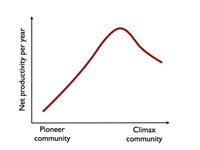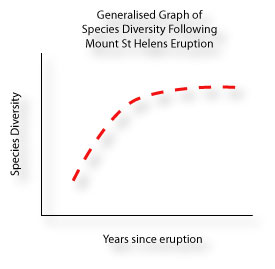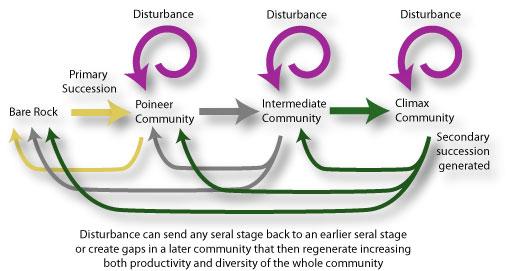2.6. 6: Succession, Productivity and Diversity.
Productivity
 During succession Gross Primary Productivity tends to increase through the pioneer and early wooded stages and then decreases as climax community reaches maturity. This increase in productivity is linked to growth and biomass.
During succession Gross Primary Productivity tends to increase through the pioneer and early wooded stages and then decreases as climax community reaches maturity. This increase in productivity is linked to growth and biomass.
Early seral stages are usually marked by rapid growth and biomass biomass accumulation - grasses, herbs and small shrubs. Gross Primary Productivity is low but Net Primary Productivity tends to be be a large proportion of GPP as with little biomass in the early seral stages respiration is low. As the community develops towards woodland and biomass increases so does productivity. But NPP as a percentage of GPP can fall as respiration rates increase with more biomass.
Studies have shown that standing crop (biomass) in succession to deciduous woodland reaches a peak within the first few centuries. Following the establishment of mature climax forest biomass tends to fall as trees age growths slows and an extended canopy crowds out ground cover. Also Older trees become less photosynthetically efficient and more NPP is allocated to none photosynthetic structural biomass such as root systems.
Biomass Accumulation and Successional Stage:
|
Early Stage
|
Middle Stage
|
Late Stage
|
|---|---|---|
|
Low GPP but High percetage NPP Little increase in biomass |
Gross Productivity high increased photosynthesis Increases in biomass as plant forms become bigger |
Tree reach their maximum size Ratio of NPP to R is roughly equal
|
Biodiversity
 Early stages of succession tend to be marked by few species within the community. As the community passes through subsequent seral stages so the number of species found increases. Very few pioneer species are ever totally replaced as succession continues. The result is increasing diversity - more species. This increase tends to continue until a balance is reached between possibilities for new species to establish, existing species to expand their range and local extinction. Evidence following the eruption of the mount St Helens volcano in 1980 has provided ecologists with a natural laboratory to study succession. In the first 10 years after the eruption species diversity increased dramatically but after 20 years very little additional increase in the diversity occurred1
Early stages of succession tend to be marked by few species within the community. As the community passes through subsequent seral stages so the number of species found increases. Very few pioneer species are ever totally replaced as succession continues. The result is increasing diversity - more species. This increase tends to continue until a balance is reached between possibilities for new species to establish, existing species to expand their range and local extinction. Evidence following the eruption of the mount St Helens volcano in 1980 has provided ecologists with a natural laboratory to study succession. In the first 10 years after the eruption species diversity increased dramatically but after 20 years very little additional increase in the diversity occurred1
Disturbance
Early ideas about succession suggested that the Climax community of any area was almost self perpetuating. This is unrealistic as communities are affected by periods of disturbance to greater or lesser extent. Even in large forests trees eventually age, die and fall over leaving a gap. Other communities are affected by flood, fire, land slides earthquakes, hurricanes etc. All of these have an effect of making gaps available that can be colonised by pioneer species within the surrounding community. This adds to both the productivity and diversity of the community.

- Carey, Susan, John Harte & R. del Moral. 2006. Effect of community assembly and primary succession on the species-area relationship in disturbed systems. Ecography 29:866-872. [↩]